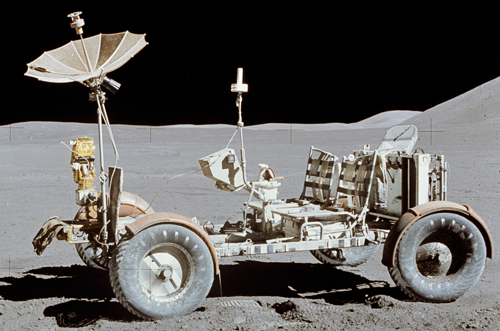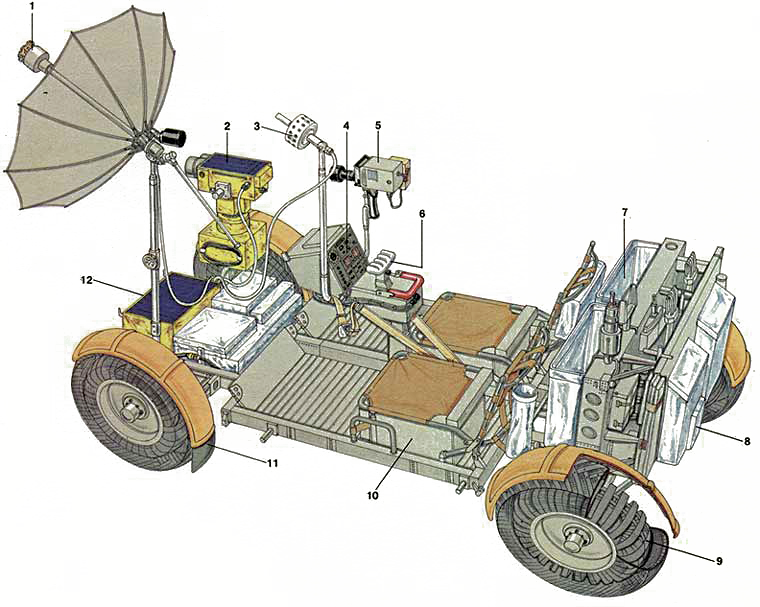Moon car
Probably many people know this car:


This lunar self-propelled vehicle (Lunar Roving Vehicle, LRV), which astronauts traveled, was developed by Boeing in 1969-1971. $ 19 million was allocated for its design, but Boeing specialists failed to meet this amount, and the first such machine cost $ 38 million. With a weight of 209 kg, the LRV was able to carry two astronauts in space suits with PLSS knights weighing 180 kg each and another 130 kg of cargo. Rover systems, including four motor-wheels, were powered by two 36-volt silver-zinc batteries with a capacity of 120 Ah. The maximum range was 65 km. All four wheels of the lunar rover were leading. When folded, the lunar rover is placed in the landing stage of the lunar cabin. The volume it occupies does not exceed 0.85 cubic meters.
')

In their hubs there was an electric motor with a power of 0.25 hp. and a mechanical gearbox with a gear ratio of 80: 1. There were also two independent 0.1 hp electric motors. - front and rear - to rotate the wheels, they worked in tandem with the gear with a gear ratio of 257: 1. The wheels were woven from galvanized piano wire and fitted with titanium plates for improved grip and protection against wire rim wear. Although the lunar rover could be accelerated to a speed of 16 km / h, mostly astronauts moved slower - 9–10 km / h. Too much speed transformed the rover into an “unbroken horse”, frighteningly rearing up at each strike against an unnoticed barrier. The moon rover was controlled by a lever located between the pilots' seats. And despite the fact that all the astronauts terribly wanted to steer the lunar rover, only the crew commander was allowed to operate. A total of four flight models of rovers were built - three of them were intended for Apollo 15, 16 and 17 missions, and another was used as a source of spare parts after the cancellation of plans for the next lunar missions.
During the Apollo 16 expedition, the record for the speed of movement across the moon was set at 18 km / h.
Scheme:

1 Pointed antenna.
2 TV camera.
3 Low-directional antenna.
4 Remote control.
5 Movie Camera (16 mm).
6 Control knob.
7 Containers for lunar samples.
8 Equipment and tools.
9 Wheel with wire rim.
10 Containers under the seats.
11 Dust protection.
12 Transceiver equipment for direct communication with the Earth.
Specifications
The length is 3.1 m.
Track width 1.82 m.
Wheelbase 2.3 m.
Wheel diameter is 81.3 cm.
Ground clearance 35.5 cm. Turning radius 3.05 m.
Maximum speed of about 18 km / h.
Operation of the Lunokhod

A folded lunar “jeep” with an electric motor is stored upside down in the landing stage of the lunar cabin, from where an astronaut can remove it with the help of two nylon cables.
The moon rover is deployed semi-automatically.
1 Lunokhod is removed from the landing stage of the lunar cabin.
2 The rear chassis section tilts and the rear wheels are locked in place.
3 The rear wheels fall to the ground, the front chassis section tilts and the front wheels are locked in the working position.
4 An astronaut lowers the front wheels to the ground. Now he can install the seats and footrests.
Schemes taken from the book "Space Technology"


This lunar self-propelled vehicle (Lunar Roving Vehicle, LRV), which astronauts traveled, was developed by Boeing in 1969-1971. $ 19 million was allocated for its design, but Boeing specialists failed to meet this amount, and the first such machine cost $ 38 million. With a weight of 209 kg, the LRV was able to carry two astronauts in space suits with PLSS knights weighing 180 kg each and another 130 kg of cargo. Rover systems, including four motor-wheels, were powered by two 36-volt silver-zinc batteries with a capacity of 120 Ah. The maximum range was 65 km. All four wheels of the lunar rover were leading. When folded, the lunar rover is placed in the landing stage of the lunar cabin. The volume it occupies does not exceed 0.85 cubic meters.
')

In their hubs there was an electric motor with a power of 0.25 hp. and a mechanical gearbox with a gear ratio of 80: 1. There were also two independent 0.1 hp electric motors. - front and rear - to rotate the wheels, they worked in tandem with the gear with a gear ratio of 257: 1. The wheels were woven from galvanized piano wire and fitted with titanium plates for improved grip and protection against wire rim wear. Although the lunar rover could be accelerated to a speed of 16 km / h, mostly astronauts moved slower - 9–10 km / h. Too much speed transformed the rover into an “unbroken horse”, frighteningly rearing up at each strike against an unnoticed barrier. The moon rover was controlled by a lever located between the pilots' seats. And despite the fact that all the astronauts terribly wanted to steer the lunar rover, only the crew commander was allowed to operate. A total of four flight models of rovers were built - three of them were intended for Apollo 15, 16 and 17 missions, and another was used as a source of spare parts after the cancellation of plans for the next lunar missions.
During the Apollo 16 expedition, the record for the speed of movement across the moon was set at 18 km / h.
Scheme:

1 Pointed antenna.
2 TV camera.
3 Low-directional antenna.
4 Remote control.
5 Movie Camera (16 mm).
6 Control knob.
7 Containers for lunar samples.
8 Equipment and tools.
9 Wheel with wire rim.
10 Containers under the seats.
11 Dust protection.
12 Transceiver equipment for direct communication with the Earth.
Specifications
The length is 3.1 m.
Track width 1.82 m.
Wheelbase 2.3 m.
Wheel diameter is 81.3 cm.
Ground clearance 35.5 cm. Turning radius 3.05 m.
Maximum speed of about 18 km / h.
Operation of the Lunokhod

A folded lunar “jeep” with an electric motor is stored upside down in the landing stage of the lunar cabin, from where an astronaut can remove it with the help of two nylon cables.
The moon rover is deployed semi-automatically.
1 Lunokhod is removed from the landing stage of the lunar cabin.
2 The rear chassis section tilts and the rear wheels are locked in place.
3 The rear wheels fall to the ground, the front chassis section tilts and the front wheels are locked in the working position.
4 An astronaut lowers the front wheels to the ground. Now he can install the seats and footrests.
Schemes taken from the book "Space Technology"
Source: https://habr.com/ru/post/88427/
All Articles